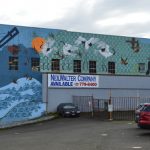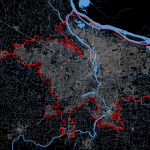
This gallery contains 1 photo.

This gallery contains 1 photo.

This gallery contains 1 photo.
Public art is the medium which democratizes the process of manufacturing an urban landscape. Buildings are the city’s trees, and the mural is raw exposure to the ecology of the urban population. Nowhere else is the process of community design more inclusive. The murals in study were created by youth in two Boston low-income communities of color. By allowing this type of participation in the city, these youth can create places for themselves in a society that often tells them there is no place for them. Public art allows communities to reflect who they are. They exist as artifacts of cultural identity. Sometimes public art is forgotten, or even painted over. This is why public art so often lends itself to community participation. It is a medium that allows for changes in the community identity. We tend to enjoy murals and other forms of public art because they add character and evidence of who lives in the community. The author argues that public art is a form of community design participation that is implementable in all communities. Further, those communities that enact legislation (design standards) that prohibit this kind of public art aim to prohibit active participation in the community.
The disconnect between learned science and understood science is the subject of Checker’s piece. Learned science is owned by the camp of “experts” those with the universally accepted credentials to evaluate an environment. Understood science is owned by the community members that observe changes in their environment. The research method of learned science fixates on a particular observation and is pigeonholed into a specific area of study which limits the range of interpretation of phenomena. The research method of understood science is based in the observation of the entire environment, without identifying control or variables. One would argue that the camp of understood science would produce the better scientific understanding. However, the inability to translate observations into an analytical understanding that can be evaluated in a causal manner gives power to the learned science discipline. In the case of Checker’s research, residents of Hyde Park are in the understood science camp and EPA scientists are of the learned science. Because learned science has the power and is unable to reach the same conclusions as understood science, they believe there is no environmental problem. However, the observations of understood science are valid. The elimination of the disconnect between trained and citizen scientists or rather, increased collaboration and understanding between the two would lead to a more holistic understanding that would prevent the marginalization of communities that are not represented by the discipline of trained science.
Globalization has both direct and indirect effects. Sawyer’s examination of oil drilling in the Ecuadorian Amazon highlights how local groups intended to prevent multinational oil companies from polluting their environment. As time went on, the organization of local leaders formed a coalition of international groups aiming to end a pattern too frequently repeated around the world: multinational corporations taking advantage of vulnerable communities. After they realized they could not achieve their desired result through direct negotiation, they turned to more direct, political action. While the oil companies are still very present and powerful in Ecuador, this issue provided a catalyst for organization among the indigenous communities of Ecuador. Throughout much of the history of development, unintended consequences have occurred, at the cost of unachieved intentions. The idea of urban development began as a more efficient way to produce food as resources were pooled so community members could engage in other activities beyond hunting and gathering. The modern community model in place around the world creates a very uneven distribution of resources. As the community has become global, so has this phenomena. In the global community, there is an uneven distribution of wealth, power, and resources. One could argue that this could have been predicted as it is rooted in nature. In all ecosystems, the predator at the top of the food chain controls all of the wealth, power, and resources. The human community is modeled by the natural ecosystem. Those at the bottom of the food chain are rising up, in spite of this, to redistribute.
Citizen science has emerged as a way to democratize scientific findings. Not all who make decisions that impact the environment come from a trained scientific background. If the scientific disciplines are to effectively convince policy makers and individual actors to adopt lifestyle changes, they must create a convincing narrative. The plight of scientists of the environment is similar to that plight of the indigenous. Indigenous peoples have always had to work on convincing the non-indigenous that they have a just claim to their existence and their protection. Since those making the policy do not share the same experience, they have to create an effective narrative to convince them to agree to their argument. Scientists, as the voice for the environment, possess the same challenge. In recent history, correlations between destructions of environments and indigenous communities revealed that environmentally destructive actions by non-indigenous communities result in simultaneous degradation of indigenous communities. Environmentalists have drawn further correlation, as Brosius notes, between environmental knowledge and the indigenous peoples due to their close-knit connection to their landscape. Environmentalists have discovered that they posses a unique environmental knowledge is difficult to describe in scientific terms. Scientists have been able to use this knowledge as the basis for effective conservation narratives. Environmentalists have capitalized on encouraging the low-footprint lifestyles of native peoples as a mechanism of sustainable living. The protection of human and natural communities must be directly correlated and presented to those with power in narratives that balance scientific and cultural knowledge in a socially-approachable manner.
As authors Robert Todd Perdue and Gregory Pavela explain, the impact that natural resource extraction has on a community is much more closely related to time than originally thought. The case study in West Virginia highlights the extraction of coal as an example of a finite resource being exhausted and the impact that has on a community. While the short term benefits are abundant, they quickly dissipate and leave communities lacking in an sort of economic advantage. Tactics by some attempt to convince these rural communities that their prosperity is like urban environments (fluctuates in the short term but generally increases over the long run), and that the economic benefits will return. However, this is not the case as prosperity is directly correlated with economic opportunity. Once finite natural resources are extracted, the economic opportunity connected to them has been spent and, like the resource, will not replenish. These communities are even worse off because the extraction activities can pollute the environments so much that at a minimum quality of life is reduced but more commonly, public health is reduced as chronic illnesses and death increase. There is a clear pattern of predatory behavior by corporations and governments that exploits these vulnerable communities by exhausting their only economic advantage. These communities are often poor and lacking in alternatives so they accept this fate. Per the data highlighted in this article, market price of surface coal is correlated with per capita income and market cost is correlated with unemployment. This is an example of urban privilege. Cities have the benefit of enjoying a diversity of economic opportunities while rural areas are mono-dependent on a single opportunity. It is decisions and the demand of those in urban areas that destroys the economic mobility of rural.
The Wari’ people are a indigenous Amazonian group with a complex understanding of our concepts of body, soul, and humanity. The Wari’ see these concepts as fluid, rather than stagnant. Additionally, these concepts are applied more broadly to living and non-living things rather than being restricted to humans or even living things. Aparecida Vilaça’s study of this rich culture makes an attempt to translate the Wari’ ideology in terms of our own understood constructs of body, soul, and humanity. These Chronically Unstable Bodies possess a possessive kwere which is used to describe the Wari’ concept of body. Much of the Wari’ understanding relates back to this concept of kwere. In fact, even reproduction is understood as reconstruction of the body rather than creation. Other concepts like humanity are seen as a condition, rather than an identity. Such a condition (wari’) is applied to a diversity of beings. This condition is based on geographic proximity, so all beings within proximity to the Wari’ are considered to be a member of the wari’ identity. In their understanding of what we would refer to as the soul, the jam is a source of instability within a being. Jam can be lost by being, such as spider monkeys, and beings seen as healthy and active are without jam. Vilaça recognizes that there is a rich culture in the Wari’ understanding of life and one’s self. This community is an example of a nature-dominated culture in which the Wari’ believe their central livelihood is dominated by these chronically unstable bodies.
While smallholder farming sacrifices direct economic and social progress, its indirect effect on economic and social systems makes it more sustainable than industrial agriculture. This argument, presented in the excerpt from Robert Netting’s book, asks three questions: What is the metric for social progress? What is sustainability? Is evolutionary progress inversely correlated with progress towards sustainability? Netting highlights the cultural evolutionist theory that a society’s agricultural productivity is directly correlated with quality of life. As less human labor is required for food production, societies are allowed to focus on their own social development. Netting’s excerpt prefaces an argument against this idea. Rather, according to Netting, small-scale (or smallholder) farming has a smaller environmental footprint which indirectly leads to social and economic benefits. Netting recognizes that it is difficult for societies to maintain their more sustainable behaviors when the alternative is a more productive, industrial solution. Still, Netting defends his claim that smallholder farming is the more sustainable food system that we, as a global culture, should be working towards. Netting’s ideas are one example of the argument that occurs between culture and nature. Smallholder farming occurs in the area of defining culture within nature. That is, the practice of farming occurs as a cultural necessity (a social construct required for economic vitality). Industrial agriculture, however, is nature defined within culture. Biological productivity is seen as a system, regulated and maintained through industrial processes. Any attempt to define nature, within culture, as Netting claims, is unsustainable.